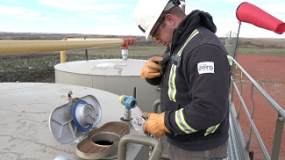NIOSH and CDPH-OHB Video Released: Oil and Gas Tank Gauging
August 22, 2017
NIOSH Update:
Press Contact: Nura Sadeghpour (202)245-0673

The National Institute for Occupational Safety and Health (NIOSH) and the California Department of Public Health, Occupational Health Branch (CDPH-OHB), recently released a video to help protect oil and gas extraction workers from the hazards they face when measuring oil storage tanks. The video, Protecting Oil and Gas Workers from Hydrocarbon Gases and Vapors, weaves together a narrative of the health and safety risks involved with this activity, and how employers and workers can reduce injuries and fatalities from exposure to toxic gases and oxygen-deficient atmospheres.
Over 500,000 workers are employed in the oil & gas industry, a workforce that is critical to the energy infrastructure of the nation. In the video, the experiences of oil and gas workers who are responsible for measuring tank levels, or tank gauging, and the sampling of crude oil are told from the heart by a truck owner/operator, a company operations superintendent, and the widow of a man who died of sudden cardiac death while gauging.
These workers often work long shifts, the weather can be severe, and many work at night or alone. From 2010-2014, there were at least 9 deaths associated with exposure to a mixture of hydrocarbon gas and insufficient oxygen when the thief hatch at the top of the storage tank was opened. The results of an overexposure can be immediate; the gases affect eyes, lungs and the central nervous system, and can cause the heart to have abnormal rhythms resulting in dizziness and disorientation, loss of consciousness, and even sudden cardiac death.
The new video highlights crucial information that is covered in the 2016 NIOSH-OSHA Hazard Alert: Health and Safety Risks for Workers Involved in Manual Tank Gauging and Sampling at Oil and Gas Extraction Sites. Visuals depict the reality of this type of work and the following recommendations are described and demonstrated:
- Employers: Implement engineering controls that eliminate the need to open tank hatches (i.e. thief hatches); conduct hazard assessments and determine necessary controls to protect workers; communicate information to onsite workers and offsite contractors; train workers on proper use of controls and in emergency response procedures.
- Workers: Inform designated personnel when beginning and finishing work; remove all items that could spark or ignite flammable gas; wear appropriate PPE, including a properly calibrated and tested multi-gas monitor; bleed off pressure using the right tools; determine wind direction when manually gauging; stay informed.
The potential hazards to workers who manually gauge or sample fluids on production and flowback tanks, such as exposure to hydrocarbon gases and vapors, oxygen-deficient atmospheres, and fires and explosions, are ones that can be prevented. The operations superintendent featured in the video, who has been in the industry for more than thirty-five years, describes how he feels: “Our main goal is to get these workers off the tank where they don’t need to be and back home safe with their families.” This, too, is NIOSH’s goal.
To access the video on YouTube: https://www.youtube.com/watch?v=VQU5–0oWLI. For more information on oil and gas: https://www.cdc.gov/niosh/programs/oilgas/default.html
To download a free copy of the video, visit https://vimeo.com/224981006
To receive free copies of the DVD, contact: acompton@cdc.gov
NIOSH is the federal institute that conducts research and makes recommendations for preventing work-related injuries and illnesses. More information about NIOSH can be found at www.cdc.gov/niosh.
